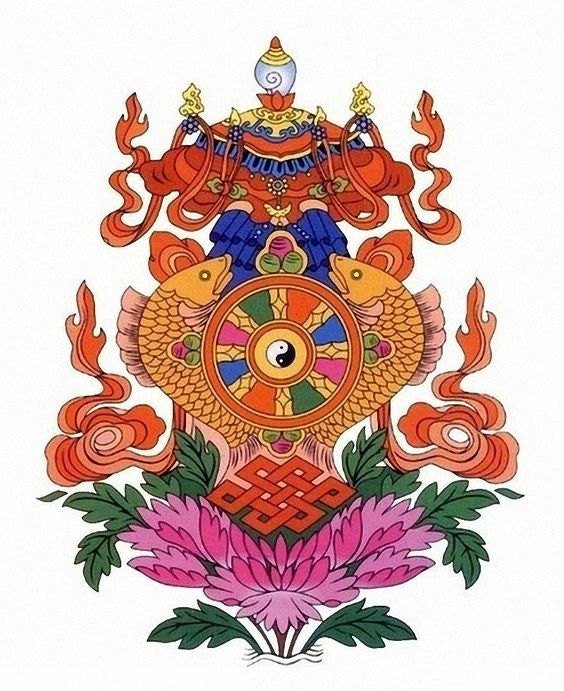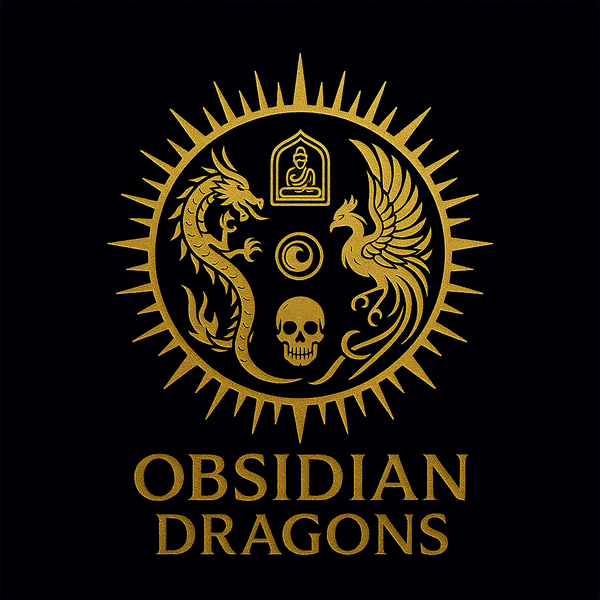
Astamangala- The 8 auspicious symbols of Buddhism
Share
The 8 auspicious signs of Buddhism or Astamangala were originally a set of Indian offerings presented to a king at his investiture. Jainism first took up these auspicious symbols probably before Buddhism.
In Buddhist tradition, these 8 auspicious signs represent the offerings presented by the great Vedic gods – an ancient civilization of India at the origin of Hinduism – to the Buddha Siddhartha after his Awakening. Brahma was the first of these gods to appear even before the Buddha was born, presenting him with a wheel with a thousand golden spokes, as a symbolic request to the Buddha to transmit his teachings by “turning the wheel of the Dharma”. Indra, Lord of Heaven and god of war and storm – and incidentally king of the gods – appeared next, offering the white conch so that the Buddha would “proclaim the truth of the Dharma”.
In Buddhist tradition, the eight auspicious signs form the body of Buddha.
the parasol represents his head, the two fish his eyes, the vase his neck, the lotus his tongue, the golden wheel his feet, the victory banner his body, the conch his speech, the endless knot his spirit.

In the earliest form of Indian Buddhism, the Buddha was depicted aniconically, that is, without being represented in human form, usually by an empty throne under a parasol and under the Bodhi tree or by a stone marked with his divine imprints, which contain several auspicious symbols such as the insignia of the Buddha's divinity: the banner of victory, the lion throne, the trident, the Three Jewels, the eternal knot, the swastika, the conch, the pair of fish and the most common, the lotus and the wheel.
The Endless Knot or Tibetan Infinite Knot is a Buddhist symbol that represents the movement of that which is eternal, of intertwining spiritual paths and of time. The shape of the Endless Knot is evocative of wisdom and compassion in Tibetan Buddhism. The top and bottom of the symbol symbolize the interaction of opposing and dual forces, which ultimately come together and unite in the universe. The Tibetan Infinite Knot also represents the inseparability of the Void and the reality of existence. Finally, since the Knot has no beginning or end, it is also defined as the Wisdom of Buddha.

A traditional instrument of Tibet, the conch is considered to be the symbol of the power of the Buddha's speech. The dextrorotatory conch winds to the right and is the rarest and most auspicious for the practice of Tibetan Buddhism. It symbolizes the sound of the Dharma that awakens beings from the sleep of Ignorance, thus inciting them to accomplish their own good for the good of others. It is also the protection of the Jewel of the Dharma, the progression of stages by stages towards the ultimate realization, Awakening or Illumination.

The Wheel of Dharma remains the most important symbol of Tibetan Buddhism, it symbolizes Buddhist law as well as the teaching of the Buddha who was the first to set this Wheel in motion. The Wheel of Dharma represents the eternal movement of the cycle of rebirth (or karma). It is also the continuity of the teachings of the Buddha, in all its forms and in all directions, teachings that lead to Happiness and liberation. The Wheel of Dharma is often represented with four or eight branches, embodying the Four Noble Truths and the Eight Steps.

Symbol of absolute purity and Awakening, emblem of spiritual elevation, the lotus has the particularity of taking root in the mud or the silt, its stem bathing in the water while its flower blooms majestically on the water. The lotus represents the elevation of the soul, first purely materialistic through its roots, then tasting the experience of water through its stem, to finally reach illumination and awakening through its flower.
Tibetan Buddhists see through the Lotus the true nature of Beings, the stem being samsara (cycles of life and death), the flower symbolizing peace and serenity.

The Tibetan victory banner is the symbol of Buddha's teaching, the triumph over Ignorance, Buddha's doctrine over the forces of Evil: passion, fear of death, pride and lust.
It particularly symbolizes the Buddha's renunciation of all mental disturbances and illusory appearances of samsara.

The Treasure Vase represents a multitude of wealth, intellectual and prosperity. It is a Tibetan symbol of long life and abundance.
It also symbolizes moral discipline, the study and practice of the Dharma, notably through the good that one can bring to others and the development of altruism.
When you wear a Tibetan jewel representing the treasure vase (it is not by chance that these pendants are often called "ghau" or "gao", simply because they can be filled), think about slipping inside everything that you think is beneficial for you and all living beings. This can be Tibetan mantras, or photos of people who are particularly important to you, or thoughts or prayers...

Originally, the two fish were the symbol of the Yamuna and Ganges rivers, but they later became the symbol of good fortune for Hindus and Buddhists. Among Tibetan Buddhists, the Golden Fish represents living beings who practice Dharma, and who need not fear drowning in the ocean of suffering, since they can freely swim like fish in water, in order to choose their rebirths.

The parasol symbolizes the activity that protects men from all evils: diseases, accidents, evil spirits. It also protects beings from the lower worlds. In Tibetan Buddhism, the umbrella protects us from suffering. The Tibetan umbrella is the guarantor of wisdom.
From a Buddhist perspective, the umbrella represents a form of protection and welcome to anyone who would like to enter the path of Dharma and progress on the path to Enlightenment.

